Supplementing lists with data frames
Solving data problems with multiple tools
Beyond Collections and Comprehensions
A couple days back I wrote a post summarizing how much Collections and Comprehension were used. Data was provided in the form of lists, either lists of dictionaries or tuples. And to answer questions about the data, the author often used list comprehensions - iterating through lists with a for-loop. I am beginning to see this as a very Python-centric way of approaching problems.
While not all data is tabular, so much of it is so its reasonable to assume that, more often that not, you’ll be dealing with spreadsheet-like tabular data (note: I’m open to other perspectives here, feel free to leave a comment below!).
In any case, I had this itch to go back to that chapter and ask:
How would I approach the same problem using data frames?
So that’s what this post is about. You can reference these previous post for context; also keep in mind, this is a brief detour and deviation from Joel Grus’ book (for example, I’ll be using pandas here and a jupyter notebook here, both of which are not covered in the book).
For review, here’s the data you are given as a newly hired data scientist at Data Scienster™
# users in the network
# stored as a list of dictionaries
users = [
{"id": 0, "name": "Hero"},
{"id": 1, "name": "Dunn"},
{"id": 2, "name": "Sue"},
{"id": 3, "name": "Chi"},
{"id": 4, "name": "Thor"},
{"id": 5, "name": "Clive"},
{"id": 6, "name": "Hicks"},
{"id": 7, "name": "Devin"},
{"id": 8, "name": "Kate"},
{"id": 9, "name": "Klein"}
]
# friendship pairings in the network
# stored as a list of tuples
friendship_pairs = [(0,1), (0,2), (1,2), (1,3), (2,3), (3,4),
(4,5), (5,6), (5,7), (6,8), (7,8), (8,9)]
# interests data
# stored as another list of tuples
interests = [
(0, "Hadoop"), (0, "Big Data"), (0, "HBase"), (0, "Java"),
(0, "Spark"), (0, "Storm"), (0, "Cassandra"),
(1, "NoSQL"), (1, "MongoDB"), (1, "Cassandra"), (1, "HBase"),
(1, "Postgres"), (2, "Python"), (2, "scikit-learn"), (2, "scipy"),
(2, "numpy"), (2, "statsmodels"), (2, "pandas"), (3, "R"), (3, "Python"),
(3, "statistics"), (3, "regression"), (3, "probability"),
(4, "machine learning"), (4, "regression"), (4, "decision trees"),
(4, "libsvm"), (5, "Python"), (5, "R"), (5, "Java"), (5, "C++"),
(5, "Haskell"), (5, "programming langauges"), (6, "statistics"),
(6, "probability"), (6, "mathematics"), (6, "theory"),
(7, "machine learning"), (7, "scikit-learn"), (7, "Mahout"),
(7, "neural networks"), (8, "neural networks"), (8, "deep learning"),
(8, "Big Data"), (8, "artificial intelligence"), (9, "Hadoop"),
(9, "Java"), (9, "MapReduce"), (9, "Big Data")
]
Given just these pieces of data, we can create functions, use for-loops and list comprehensions to answer some questions like:
- Who are each user friends with?
- What are the total and average number of connections?
- Which users share the same interest?
- What are the most popular topics in this network?
However, the chapter ends with lists, functions and comprehension. What about storing data in data frames?
First we’ll store users as a data frame:
import pandas as pd
# convert list of dict into dataframe
users_df = pd.DataFrame(users)
users_df
Just visually, a data frame looks different from a list of dictionaries:
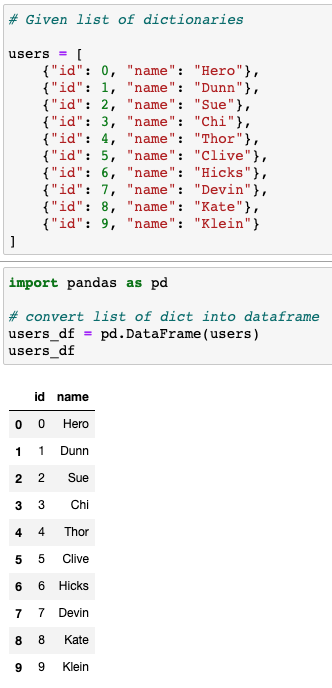
Your mileage may vary, but I make sense of the data very differently when I’m looking at a list vs a data frame. Rows and columns are ingrained in how I think about data.
Next, we’re given a list of tuples representing friendship pairs and we proceed to turn that into a dictionary by using a dictionary comprehension:
# list of tuples
friendship_pairs = [(0,1), (0,2), (1,2), (1,3), (2,3), (3,4),
(4,5), (5,6), (5,7), (6,8), (7,8), (8,9)]
# create a dict, where keys are users id,
# dictionary comprehension
friendships = {user["id"]: [] for user in users}
for i, j in friendship_pairs:
friendships[i].append(j)
friendships[j].append(i)
Similar to the previous example, I find that viewing the data as a data frame is different from viewing it as a dictionary:

From this point, I’m doing several operations in pandas to join the first two tables, such that I have a column with the user’s id, user’s name and the id of their first, second or, in some cases, third friends (at most people in this network have 3 direct connections).
If you want to know the specific pandas operation, here’s the code:
# The users_df is fine as is with two columns: id and name (see above)
# We'll transform the friendships_df
# reset_index allows us to add an index column
friendships_df.reset_index(inplace=True)
# add index column
friendships_df = friendships_df.rename(columns = {"id":"new column name"})
# change index column to 'id'
friendships_df = friendships_df.rename(columns = {'index':'id'})
# join with users_df so we get each person's name
users_friendships = pd.merge(users_df, friendships_df, on='id')
Once we’ve joined users_df and friendships_df, we have:
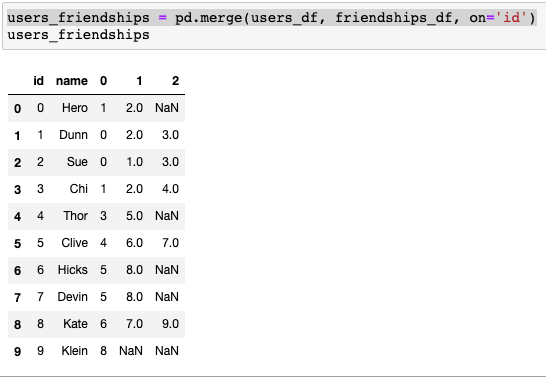
Since we have users and friendships data, we could write a function to help us answer “how many friends does each user have?". In addition, we’ll have to create a list comprehension so we loop through each user within users:
# function to count how many friend each user has
def number_of_friends(user):
"""How many friends does _user_ have?"""
user_id = user["id"]
friend_ids = friendships[user_id]
return len(friend_ids)
# list comprehension to apply the function for each user
num_friends_by_id = [(user["id"], number_of_friends(user)) for user in users]
# this gives us a list of tuples
num_friends_by_id
[(0, 2),
(1, 3),
(2, 3),
(3, 3),
(4, 2),
(5, 3),
(6, 2),
(7, 2),
(8, 3),
(9, 1)]
Again, viewing the data as a list of tuples is different from a data frame, so let’s go ahead and turn that into a pandas data frame:
# when converting to data frame, we can set the name of the columns to id and num_friends; this sets us up for another join
num_friends_by_id = pd.DataFrame(num_friends_by_id, columns = ['id', 'num_friends'])
Because we have an ‘id’ column, we can join this with our previously created users_friendships data frame:
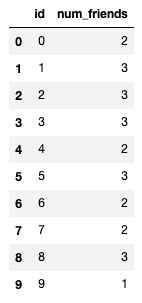
Once joined with users_friendships using the merge function, we get (users_friendships2):
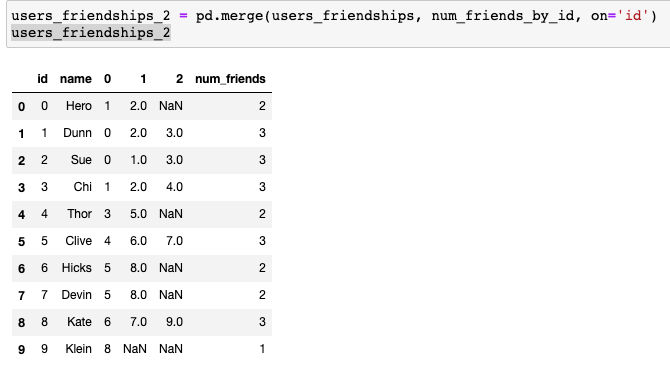
By now you’re familiar with the process. We have a Python collection, generally a list of dictionaries or tuples and we want to convert them to a data frame.
We’ll repeat this process for the interests variable which is a long list of tuples (see above). We’ll convert to data frame, then join with users_friendships_2 to get a longer data frame with interests as one of the columns (note : picture is cut for space):

The nice thing about pandas is that once you have all your data joined together in a data frame, you can query the data.
For example, I may want to see all users have an interest in “Big Data”:
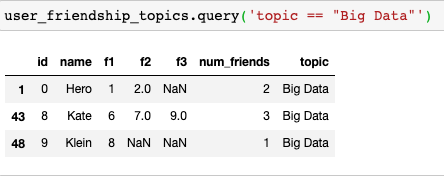
Previously, we would have had to create a function that returns a list comprehension:
def data_scientists_who_like(target_interest):
"""Find the ids of all users who like the target interests."""
return [user_id
for user_id, user_interest in interests
if user_interest == target_interest]
data_scientists_who_like("Big Data")
The data frame has other advantages, you could also query columns on multiple conditions, here are two ways to query multiple topics:
# Option One: Use .query()
user_friendship_topics.query('topic == "machine learning" | topic == "regression" | topic == "decision trees" | topic == "libsvm"')
# Option Two: Use .isin()
user_friendship_topics[user_friendship_topics['topic'].isin(["machine learning", "regression", "decision trees", "libsvm"])]
Both options return this data frame:
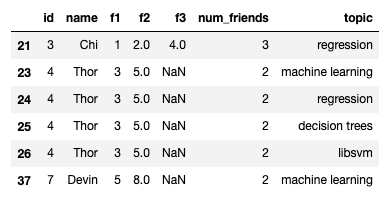
By querying the data frame, we learned:
- all users interested in these four topics
- users that have interests in common with Thor
- (if needed) the
num_friendsthat each user has
You can also find out the most popular topics within this network:
# groupby topic, tally(count), then reset_index(), then sort
user_friendship_topics.groupby(['topic']).count().reset_index().sort_values('id', ascending=False)
You can even groupby two columns (name & topic) to see topic of interests listed by each user:
user_friendship_topics.groupby(['name', 'topic']).count()
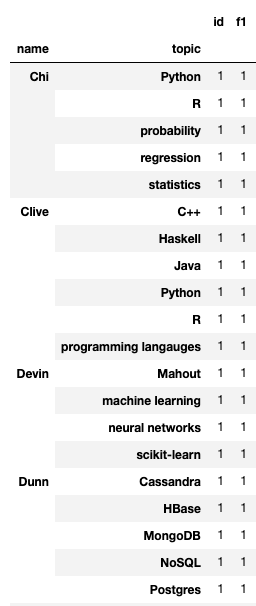
Hopefully you’re convinced that data frames are a powerful supplement to the more familiar operations in Python like for-loops and/or list comprehensions; that both are worth knowing well to manipulate data in a variety of formats. (e.g., to access JSON data, Python dictionaries are ideal).